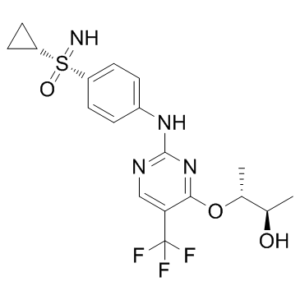Roniciclib
This product is for research use only, not for human use. We do not sell to patients.

For small sizes, please check our retail website as below: www.invivochem.com
| Size | Price | Stock |
|---|---|---|
| 50mg | $1650 | To Be Confirmed |
| 100mg | $2800 | To Be Confirmed |
| 200mg | $4200 | To Be Confirmed |
Cat #: V4211 CAS #: 1223498-69-8 Purity ≥ 98%
Description: Roniciclib (formerly also known as BAY1000394; BAY-1000394) is a novel, potent and orally bioavailable pan-cyclin dependent kinase (CDK) inhibitor wwith anticancer activity.
Top Publications Citing Invivochem Products
Publications Citing InvivoChem Products
Product Promise

- Physicochemical and Storage Information
- Protocol
- Related Biological Data
- Stock Solution Preparation
- Quality Control Documentation
| Molecular Weight (MW) | 430.44 |
|---|---|
| Molecular Formula | C18H21F3N4O3S |
| CAS No. | 1223498-69-8 |
| Storage | -20℃ for 3 years in powder formr |
| -80℃ for 2 years in solvent |
| Protocol | In Vitro | Roniciclib (BAY 1000394) inhibits kinase activity of cell cycle CDKs CDK1/cyclin B, CDK2/cyclin E, and CDK4/cyclinD, IC50 The values are 7, 9, and 11 nM, respectively. Transcription of CDKs CDKs CDK9/cyclin T1 and CDK7/cyclin H/MAT1 were inhibited in similar ranges (5 and 25 nM) |
|---|---|---|
| In Vivo | Tumor growth is strongly inhibited in a dose-dependent manner, with a T/C value of 0.19 at lower doses and 0.02 (tumor regression) at higher doses. In addition, Roniciclib strongly inhibits the growth of HeLa-MaTu tumors that have grown to approximately 8 mm in size before the start of treatment (50 days after inoculation).2 。 Treatment with Roniciclib at doses of 1.5 and 1 mg/kg resulted in slow tumor growth to T/C values of 0.15 and 0.62, respectively. The addition of Roniciclib to cisplatin yields strong tumor growth inhibition with T/C values of 0.01 (1.0 mg/kg Roniciclib) and -0.02 (1.5 mg/kg Roniciclib) |
These protocols are for reference only. InvivoChem does not
independently validate these methods.
| Solvent volume to be added | Mass (the weight of a compound) | |||
|---|---|---|---|---|
| Mother liquor concentration | 1mg | 5mg | 10mg | 20mg |
| 1mM | 2.3232 mL | 11.6160 mL | 23.2320 mL | 46.4641 mL |
| 5mM | 0.4646 mL | 2.3232 mL | 4.6464 mL | 9.2928 mL |
| 10mM | 0.2323 mL | 1.1616 mL | 2.3232 mL | 4.6464 mL |
| 20mM | 0.1162 mL | 0.5808 mL | 1.1616 mL | 2.3232 mL |
The molarity calculator equation
Mass(g) = Concentration(mol/L) × Volume(L) × Molecular Weight(g/mol)
Mass
=
Concentration
×
Volume
×
Molecular Weight*
The dilution calculator equation
Concentration(start)
×
Volume(start)
=
Concentration(final)
×
Volume(final)
This equation is commonly abbreviated as: C1 V1 = C2 V2
Concentration(start)
C1
×
Volume(start)
V1
=
Concentration(final)
C2
×
Volume(final)
V2
Step One: Enter information below
Dosage mg/kg
Average weight of animals g
Dosing volume per animal µL
Number of animals
Step Two: Enter the in vivo formulation
%DMSO
+
%
+
%Tween 80
+
%ddH2O
Calculation Results:
Working concentration:
mg/ml;
Method for preparing DMSO master liquid:
mg
drug pre-dissolved in
µL
DMSO(Master liquid concentration
mg/mL)
,Please contact us first if the concentration exceeds the DMSO solubility of the batch of drug.
Method for preparing in vivo formulation:
Take
µL
DMSO master liquid, next add
µL
PEG300, mix and clarify, next add
µL
Tween 80,mix and clarify, next add
µL
ddH2O,mix and clarify.
Note:
- (1) Please be sure that the solution is clear before the addition of next solvent. Dissolution methods like vortex, ultrasound or warming and heat may be used to aid dissolving.
- (2) Be sure to add the solvent(s) in order.




































